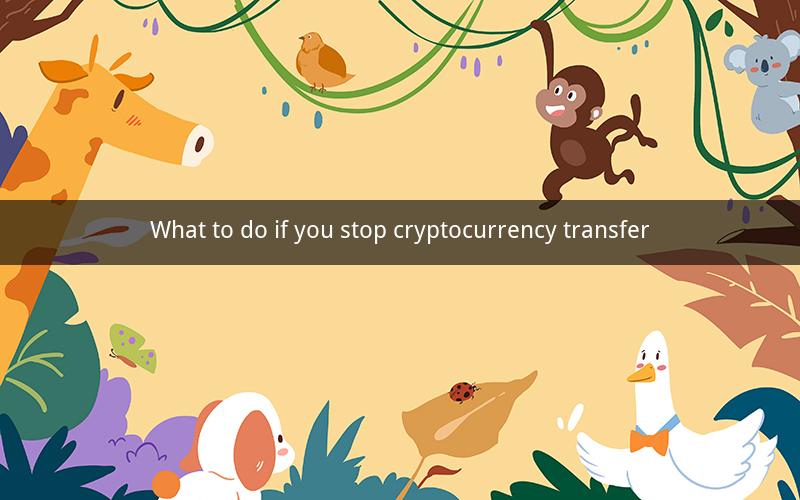
Table of Contents
1. Understanding Cryptocurrency Transfer
2. Common Reasons for Stopped Cryptocurrency Transfers
3. Steps to Take When Your Transfer is Stopped
4. Contacting the Cryptocurrency Exchange or Wallet
5. Verifying the Transaction Details
6. Checking for Network Issues
7. Resolving Unconfirmed Transactions
8. Understanding Cryptocurrency Fees
9. Preventing Future Transfer Issues
10. Conclusion
---
1. Understanding Cryptocurrency Transfer
Cryptocurrency transfers are a fundamental aspect of the blockchain technology. They allow users to send and receive digital assets securely and efficiently. However, sometimes these transfers can be stopped, leaving users in a state of uncertainty. Understanding the process and the potential reasons behind a stopped cryptocurrency transfer is crucial for anyone involved in the digital currency space.
2. Common Reasons for Stopped Cryptocurrency Transfers
Several factors can cause a cryptocurrency transfer to be stopped. These include:
- Insufficient Balance: Attempting to send more cryptocurrency than you possess in your wallet.
- Network Congestion: High transaction volume can lead to network congestion, causing delays and potential transfer failures.
- Incorrect Address: Sending cryptocurrency to an incorrect address can result in permanent loss.
- Exceeding Fees: Insufficient fees can lead to your transaction being ignored by the network.
- Blockchain Issues: Sometimes, the blockchain itself may experience issues, such as forks or other technical problems.
3. Steps to Take When Your Transfer is Stopped
When your cryptocurrency transfer is stopped, here are the steps you should follow:
- Check Your Wallet Balance: Ensure that you have enough cryptocurrency to complete the transfer.
- Review the Transaction Details: Double-check the recipient's address, the amount, and the transaction fee.
- Wait for Network Confirmation: If the network is congested, the transaction may take longer to confirm. Be patient and wait for the required number of confirmations.
4. Contacting the Cryptocurrency Exchange or Wallet
If the above steps do not resolve the issue, it's time to contact the cryptocurrency exchange or wallet provider. Here's how to do it:
- Find Contact Information: Look for the support page on the exchange or wallet's website.
- Choose the Right Channel: Determine whether to use email, live chat, or a support ticket system.
- Provide Detailed Information: Clearly explain the issue, including the transaction details and any error messages you received.
5. Verifying the Transaction Details
When contacting support, ensure you have all the necessary information to verify the transaction details. This includes:
- Transaction ID: A unique identifier for your transaction.
- Recipient Address: The address to which you sent the cryptocurrency.
- Amount Sent: The amount of cryptocurrency you intended to send.
- Transaction Fee: The fee you paid for the transaction.
6. Checking for Network Issues
Sometimes, network issues can cause transfers to be stopped. Check the following:
- Network Status: Visit the blockchain explorer for your cryptocurrency to see if there are any ongoing issues.
- Transaction Mempool: Ensure your transaction is in the mempool (the pool of unconfirmed transactions).
7. Resolving Unconfirmed Transactions
If your transaction is unconfirmed, here are some steps to resolve the issue:
- Increase the Transaction Fee: Pay a higher fee to incentivize miners to include your transaction in the next block.
- Wait for Network Confirmation: If the network is not congested, your transaction may be confirmed in a few minutes.
- Use a Different Blockchain Explorer: Try checking your transaction on a different blockchain explorer to see if it's recognized.
8. Understanding Cryptocurrency Fees
Cryptocurrency fees are essential for maintaining the network's efficiency. Here's what you need to know:
- Transaction Fees: A small fee paid to miners for processing your transaction.
- Network Fees: Fees charged by the network itself for confirming transactions.
- Dynamic Fees: Fees that can change based on network congestion.
9. Preventing Future Transfer Issues
To prevent future transfer issues, consider the following tips:
- Backup Your Wallet: Regularly backup your wallet to prevent loss of funds.
- Use Secure Connections: Avoid sending cryptocurrency over unsecure networks.
- Stay Informed: Keep up with the latest updates and news about your cryptocurrency.
10. Conclusion
Stopped cryptocurrency transfers can be frustrating, but understanding the process and taking the appropriate steps can help resolve the issue. By following the steps outlined in this article, you can increase your chances of successfully completing your cryptocurrency transfer.
---
Questions and Answers
1. Q: What should I do if my cryptocurrency transfer is stuck?
A: Check your wallet balance, review the transaction details, wait for network confirmation, and contact support if necessary.
2. Q: Why is my cryptocurrency transfer taking so long?
A: It could be due to network congestion, insufficient fees, or blockchain issues. Check the network status and consider increasing the transaction fee.
3. Q: How can I verify the transaction details?
A: Use the transaction ID, recipient address, amount sent, and transaction fee to verify the details.
4. Q: What should I do if my transaction is unconfirmed?
A: Increase the transaction fee, wait for network confirmation, or use a different blockchain explorer.
5. Q: How can I prevent future transfer issues?
A: Backup your wallet, use secure connections, and stay informed about your cryptocurrency.
6. Q: What are cryptocurrency fees?
A: Cryptocurrency fees are small payments made to miners for processing transactions and maintaining the network.
7. Q: How can I contact support for my cryptocurrency exchange or wallet?
A: Look for the support page on the website, choose the right channel (email, live chat, or support ticket), and provide detailed information about your issue.
8. Q: What should I do if I sent cryptocurrency to the wrong address?
A: Contact the recipient and request a refund. If they don't respond, you may need to seek legal advice.
9. Q: How can I increase the transaction fee?
A: You can increase the transaction fee by modifying the transaction details before sending the cryptocurrency.
10. Q: What are the common reasons for stopped cryptocurrency transfers?
A: Insufficient balance, network congestion, incorrect address, exceeding fees, and blockchain issues.